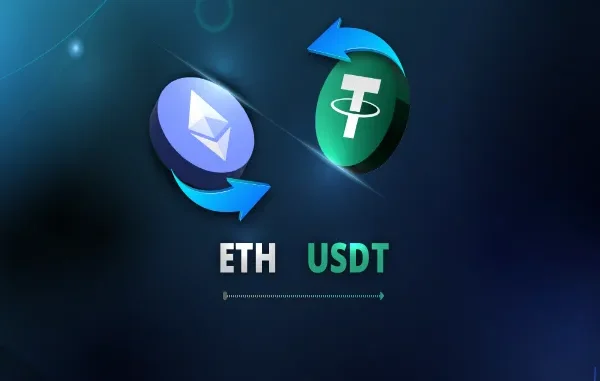
If you’ve spent more than five minutes in any crypto wallet, DeFi app, or instant crypto exchange this year, you’ve probably noticed something weird: everyone is swapping ETH to USDT. Constantly. Quietly. As if it’s just obvious.
Except… is it?
No one really explains it. There are no big headlines. No “ETH to USDT is the new alpha” tweets. Just this steady, background motion — Ethereum out, stablecoin in.
So what’s going on? Why are even longtime ETH holders converting to something as unexciting as USDT — and doing it in droves?
We’re not talking about market crashes or black swan events. We’re talking about regular, everyday use cases — payments, saving, moving between chains — and yet the shift is constant.
If you’ve ever opened your wallet and thought, “Should I swap eth to usdt? Wait… why would I?” — you’re not alone. Let’s actually unpack it.
Crypto… Wants to Chill?
There was a time when being in crypto meant you wanted volatility. The thrill of price swings, the dopamine of green candles. But here’s the shift no one saw coming: people are tired.
Not tired of crypto itself — tired of anxiety. Tired of wondering if sending $400 worth of ETH means paying $18 in gas. Tired of watching the price drop 6% between “Send” and “Confirm.”
USDT, in that context, feels like peace. Like breathing room. Like putting your money in airplane mode.
It’s not just about the dollar peg — it’s about functionality. You can send it faster. Budget with it. Sleep on it. And that’s why, despite its reputation as “boring,” USDT (especially on TRC20) is suddenly the place everyone’s parking funds before they decide what’s next.
Of All the Stablecoins, Why USDT — and Why TRC20?
USDC has the cleaner reputation. DAI is decentralized (kind of). BUSD… well, never mind. But it’s USDT that keeps showing up in swap pairs, transfer options, and wallet dashboards — especially in its TRC20 form.
And there’s a reason for that. Actually, several:
- It works. USDT is accepted literally everywhere — exchanges, dApps, P2P platforms, off-ramps. No awkward “unsupported token” messages.
- TRC20 is fast and cheap. Like, weirdly cheap. Transferring USDT on TRON can cost a fraction of a cent — and settle in seconds.
- People trust what moves. USDT might not be the most loved token in terms of branding, but it’s the most used. And that counts.
Compared to ERC20 USDT, which can randomly cost $6 to move, the TRC20 version just makes sense for small-to-medium, everyday use.
So if you’re planning to convert ETH to something stable, liquid, and easy to move around — USDT on TRC20 isn’t the elegant choice. It’s the obvious one.
It’s Not Just a Swap. It’s a Shift.
On the surface, sure — you’re just trading one token for another. ETH out, USDT in. A clean number on a screen.
But what actually changes when you swap eth to usdt?
You go from a volatile, network-fee-sensitive, gas-powered smart contract coin… to a dollar. A crypto dollar, yes. But still — a dollar.
This changes how you interact with your wallet. You stop calculating gas. You stop worrying if now is “a good time to move.” You stop refreshing charts every ten minutes.
You also open up new pathways:
- P2P exchanges become simpler
- Moving between chains or platforms is cheaper
- Spending, tipping, and saving all get easier
In short: ETH is what you use to do things. USDT is what you have while you figure out what to do next.
That’s not a downgrade. That’s strategy. Especially when the market can swing 10% in the time it takes your ETH transaction to confirm.
Tiny Mistakes, Big Consequences
Swapping ETH to USDT is easy — until it isn’t. Most issues don’t come from the swap itself, but from the details we skip because they seem obvious. Spoiler: they’re not.
TRC20 ≠ ERC20
Yes, both can hold USDT. No, they’re not the same thing. If you send to the wrong type of address, there’s a high chance your funds are gone for good. Double-check what chain you’re using. Every time.
Wrong wallet, wrong result
That one address you copied from an old exchange? Probably expired. And if it doesn’t support TRC20? It’ll silently fail, and no one can help you get it back.
Network congestion
ETH might say “sent,” but until it confirms on-chain, nothing’s moving. Don’t panic — just wait. And don’t close the tab mid-process.
Finality is final
This is crypto. There’s no “cancel” button. Once you send, the machine starts running — and it won’t stop.
So: pause. Breathe. Re-read. Then hit confirm.
So… Is Everyone Quietly Doing This, or What?
Nobody’s making TikToks about it. There’s no “swap ETH to USDT” trend with laser eyes and rocket emojis. But here’s the weird thing: it’s happening. Constantly. Quietly. Like everyone’s figured something out, but no one’s saying it out loud.
And maybe that’s the point.
This isn’t a hype move. This isn’t “buy the dip” or “ape into” something. It’s not about catching a pump or chasing a chart. Swapping ETH to USDT — especially on TRC20 — is about breathing room. It’s a move that says:
“I’m not out. I’m just off the front line for a minute.”
For freelancers and remote workers, it means invoices that aren’t melting by the hour. For casual users, it means transferring value without gas anxiety. For traders, it’s just easier to keep dry powder in stable form while waiting for a real entry.
But for a growing number of everyday crypto people? It’s just peace of mind. A way to hold value without volatility, stay on-chain without chaos, and stop waking up to minus 8% over coffee.
It’s not exiting the market. It’s participating more intentionally.
And the fact that it can happen in two minutes, without creating an account or even logging in? That’s part of why it’s so appealing. No friction. No commitment. Just flexibility — on your terms.
So if you’ve been wondering whether it’s weird to feel like you need a break from Ethereum, even if you still believe in it… no. It’s not weird.
It’s just where we are. And swapping to USDT — even temporarily — might be the most rational, least dramatic move you make all year.






Leave a Reply